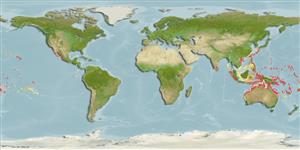Common names from other countries
>
Blenniiformes (Blennies) >
Blenniidae (Combtooth blennies) > Blenniinae
Etymology: Plagiotremus: Greek, plagios = oblique + Greek, trema = hole (Ref. 45335).
More on author: Whitley.
Environment: milieu / climate zone / depth range / distribution range
Ecologia
marino associati a barriera corallina; distribuzione batimetrica 0 - 30 m (Ref. 90102). Tropical; 33°N - 32°S
Western Pacific: Philippines and Ryukyu Islands to the Gilbert Islands, New Caledonia, and Samoa, north to Izu Islands, south to Rowley Shoals and Lord Howe Island; throughout Micronesia. Subspecies Plagiotremus laudandus flavus occurs in Fiji and Tonga.
Size / Peso / Age
Maturity: Lm ? range ? - ? cm
Max length : 8.0 cm TL maschio/sesso non determinato; (Ref. 9710)
Short description
Chiavi di identificazione | Morfologia | Morfometria
Spine dorsali (totale) : 7 - 10; Raggi dorsali molli (totale) : 27 - 30; Spine anali: 2; Raggi anali molli: 22 - 24. Color variable, usually grey-blue and posterior part of the body often paler or yellow (Ref. 48636).
Adults are found solitary in coastal, lagoon and seaward reefs from below the surge zone to 30 m depth (Ref. 9710, 90102). They feed on skin, scales, fins and mucus of other fish. Oviparous. Eggs are demersal and adhesive (Ref. 205), and are attached to the substrate via a filamentous, adhesive pad or pedestal (Ref. 94114). Larvae are planktonic, often found in shallow, coastal waters (Ref. 94114). A mimic of Meiacanthus atrodorsalis (Ref. 2334). Minimum depth reported taken from Ref. 128797.
Life cycle and mating behavior
Maturities | Riproduzione | Spawnings | Egg(s) | Fecundities | Larve
Oviparous, distinct pairing (Ref. 205).
Myers, R.F., 1991. Micronesian reef fishes. Second Ed. Coral Graphics, Barrigada, Guam. 298 p. (Ref. 1602)
IUCN Red List Status (Ref. 130435)
CITES (Ref. 128078)
Not Evaluated
Threat to humans
Harmless
Human uses
Strumenti
Special reports
Download XML
Fonti Internet
Estimates based on models
Preferred temperature (Ref.
115969): 25 - 29.3, mean 28.4 (based on 1729 cells).
Phylogenetic diversity index (Ref.
82804): PD
50 = 0.5005 [Uniqueness, from 0.5 = low to 2.0 = high].
Bayesian length-weight: a=0.00562 (0.00258 - 0.01228), b=3.06 (2.87 - 3.25), in cm Total Length, based on LWR estimates for this (Sub)family-body shape (Ref.
93245).
Trophic level (Ref.
69278): 4.4 ±0.80 se; based on food items.
Resilienza (Ref.
120179): Alto, tempo minimo di raddoppiamento della popolazione meno di 15 mesi (Preliminary K or Fecundity.).
Fishing Vulnerability (Ref.
59153): Low vulnerability (10 of 100).
